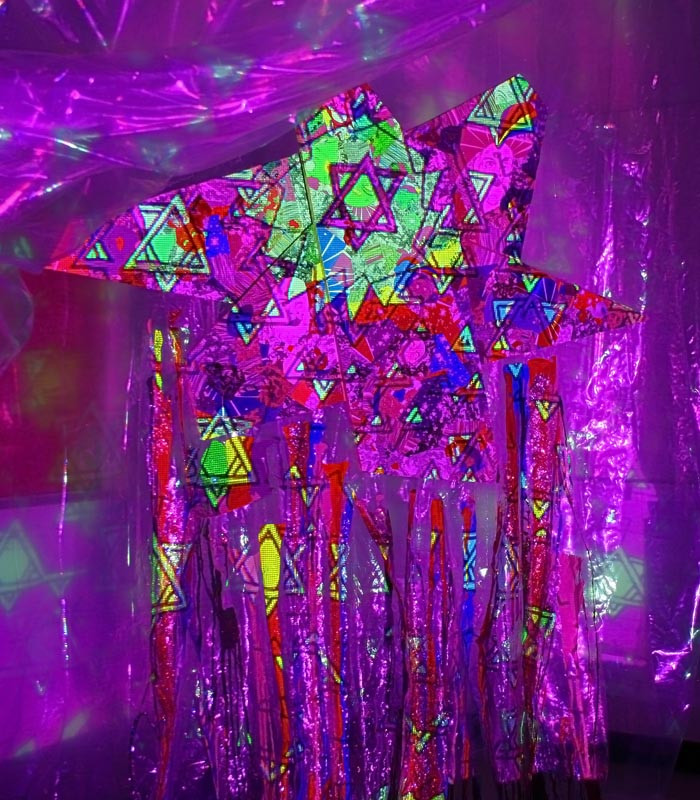Why Trans Art Matters
If Not Here, Then Where?
Religious symbolism, art space and the curating process in Concordia’s student-led Art Matters Festival are some core questions at the centre of recent speculation following a decision to deny local trans artist Johnston Newfield’s installation “Embark” into the exposition “Enter the Foam & Achieve Second Sight.”
Hearing no word from the festival after dropping off his application in January, Newfield sought out the curators and was told that including “Embark” in the exhibit would have changed the atmosphere of their show too much due to the iconography it featured.
A “politically-charged reconstruction of spirituality and identity,” Newfield’s multi-media piece incorporates installation, looped sound and projection of drawings and symbols—including the Merkaba, a icon commonly recognized as akin to the Star of David, but predates its use in Judaism as a “divine light vehicle” to unite with higher realms of existence.
“This piece is about me coming out as being Trans and how being Trans has inspired a search for re-imagining spirituality—specifically that gender is a spiritual experience,” explained Newfield, whose mother is a priest. “This perception was very clear in my artist’s statement, but I was told that it was the symbol [that was problematic].”
The exhibition he pitched to, Enter the Foam & Achieve Second Light, curated by Jerome Nadeau and Patryk Stasieczek, deals with space “[that is] of the mind, abstraction revealing dimensions composed of altered states of holographic being. These pockets of infinite perception are projected outward. As art, they evoke intimate tensions of existence that are external/external.”
For Newfield, declining “Embark” for this direction exposes a trend in the art world that embraces “the curator as artist”—something Newfield believes is to the detriment of alternative and evocative artwork that could go against the predetermined themes.
Repeatedly explaining that they have “no intention to throw stones” at the Art Matters Festival or the students who work hard to make it happen each year, Newfield told The Link they feel that the curatorial powers and the process that decides what gets accepted into each show should perhaps be challenged and re-examined.
“This [process] is really problematic, since it’s giving curators total power to select and filter art based on its decided theme, not based on the art’s own merit, or if it explores something different,” said Newfield. “To me it seemed like a lack of interest in creating an alternate space to the theme for queer and trans narratives.”
But co-curators of Enter the Foam & Achieve Second Sight and the Art Matters Production team disagrees.
“We just didn’t choose Johnston’s work and that’s just how it went. […] This is not censorship,” said Patryk Stasieczek, who was selected to organize the exhibit from over 85 curator applicants, and said he went through a “totally transparent, totally anonymous” curation process—which filtered through 400 artist applicants over a two-day jury.
“Works get selected based on how well it rests within the whole, as per [the decisions of the] curatorial team or curator,” Stasieczek explained. “Our role is to find cohesion between all the pieces, […] and because of the type of show we wanted to create, that narrative, that interplay, that tension between each work is an important factor. The work is selected if it fits.”
Enter the Foam & Achieve Second Sight is also going to be collaborating with three other shows and vernissages throughout its stint at the Eastern Bloc gallery space, which Stasieczek said involves 80 hour weeks and is a huge collaborative process.
“We’ve been putting a lot of work to make it something that will actively engage the many, many participants, and to have a dialogue with the shows we’re sharing the space with,” he explained. “There’s a lot of considerations that we’ve made for the process and activity of facilitating a dialogue between all the works.”
For Stasieczek, the charge of censorship is absolutely unfounded, and he explained that he doesn’t believe that suppressing artists is an issue anymore, as “there are too many other outlets for expression.”
For “Embark,” these other channels came via a proposal by Radical Queer Semaine—a 10-day, bilingual queer community-building program of dialogue, activism, workshops and art—to host the installation, and the collective asked Newfield to participate in a reactionary multimedia art event, teasingly entitled “Art Natters,” on March 10.
Finding a space for the art after all, Newfield believes that things worked out better in the end.
“This whole process has been an interesting experience and I just want the ideas to continue to be discussed,” said Newfield, who explained that he hopes the minor controversy opens up questions of censorship and curatorial power in the Concordia art world and beyond. “I think it’s good that someone is taking it up and asking the questions.”
More Information:
Enter the Foam & Achieve Second Sight / March 1 – 19 / Eastern Bloc (7240 Clark) / 6 – 9 p.m.
Vernissage / March 1 / 6 p.m. – 9 p.m.
Art Natters / March 10 – 20 / Mise au Jeu (90 rue de la Gauchetière Est)
Vernissage / March 10 / 10 p.m.
_ Johnston Newfield’s website is www.johnstonnewfield.com_
This article originally appeared in Volume 31, Issue 24, published March 7, 2011.


_600_832_s.png)
